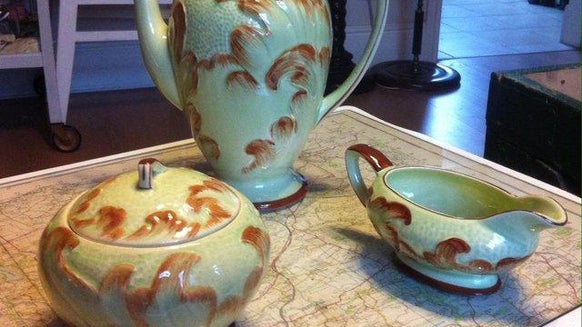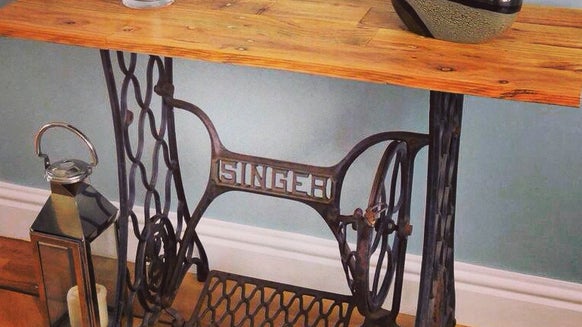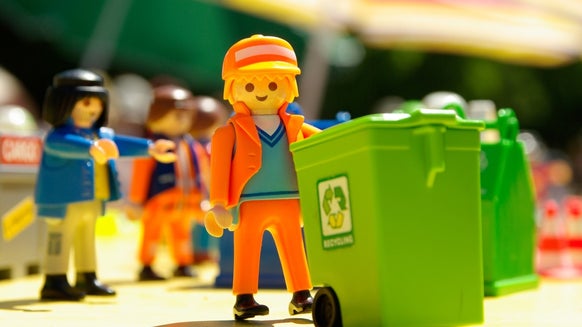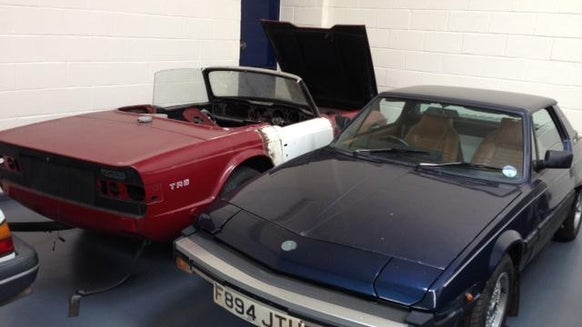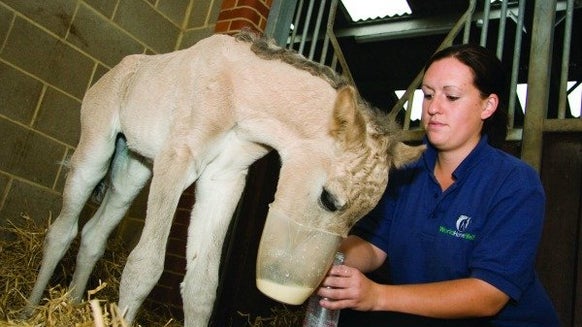Upcycled Ambitions

Preloved member Carla Muncaster has turned a second hand hobby into a first-rate business idea. She tells us how she upcycles vintage furniture to give beautiful older pieces a brand new lease of life
Tell us a little bit about how and when you started your business
Selling vintage furniture happened quite by accident, really. I'm an interior designer and when I was sourcing a dressing table for a client a few months ago I ended up buying a whole set of bedroom furniture from a charity shop because the dressing table could not be sold separately. So, after upcycling the dressing table for my client I got to work stripping and painting the wardrobe and two bedside cabinets which I sold. The idea was then born to do more of this kind of work if ever I was quiet and it didn't take long to get off the ground.
Where do you work from?
There's a large double garage at the back of our house so I got in touch with the freeholder and asked if I could rent it off him and he agreed. So began the biggest garage clear out mission I've ever encountered. He used the garage to store all his weird and wonderful treasures collected over many years of adventures. There was a rucksack he'd used to climb the Matterhorn, windsurfers, antlers, car parts, loads of tyres, crampons, fireplaces... It was a real Aladdin's cave that took five of us several days to clear it out. And there it was: my workshop and warehouse all rolled into one in my back garden. I had electricity run to it and fitted some lights and set about filling it up with tired, yet beautiful, furniture that I could restore.
When did your interest in vintage furniture begin?
For as long as I can remember I've been interested in interiors and furniture. I was always asking to re-decorate my bedroom as a child. I remember the first time I went into an antique shop to buy a pine chest of drawers for my newly-designed bedroom. I was the only 12-year-old I knew that didn't cover their bedroom in posters of Wham and Bros! My mum was always sanding something down or re-upholstering a sofa or something, so I guess I just inherited the bug and it's never gone away. I just can't walk past a charity shop or a flea market and not dive in for a good rummage!
What is its appeal as opposed to new furniture?
It's so much sturdier than some of the modern stuff, and by that I mean the flat-pack type. I've worked as a buyer and in product development for some leading luxury homeware stores and the furniture we sold was amazing and was often made using traditional techniques with quality responsibly sourced wood, but it cost a small fortune! So, although I loved it, I could never afford it. The modern furniture within my budget lacks personality and looks so boring when it's new and just tatty when the veneer chips (which it always does) as it gets older. It doesn't feel good to the touch and doesn't sound good when the drawers slide in and out or the doors catch. Vintage furniture is the total opposite. I adore its solidness, its weight, the grain of the wood, the naturally distressed look, dovetail joints, little casters and the expertly carved embellishments. And I love that it's almost certain that none of my friends will have the same pieces in their homes!
 Where do you find the pieces?
Where do you find the pieces?
 Where do you find the pieces?
Where do you find the pieces?Mainly charity shops, but also vintage fairs, antique shops, skips, friends donate pieces to me and even freecycle. This year I'm hoping to head over to some of the French flea markets - I can't wait!
How long does it take to renovate a piece?
It really depends on what it is and how fiddly it might be or how damaged it is. I have a huge sideboard in my workshop at the moment which I haven't attempted to start work on because I know it's going to take days and days… The drawers are all broken, the legs are wonky, there are some really intricate twisty details and lots of the decorative strips of beaded wood have fallen off. But other items can take just a few hours, which is great because it keeps the turnover healthy and the work interesting.
Talk us through the process of upcycling an old piece?
Generally I start by sanding down. I almost always find pieces which are covered in paint or varnish, which has undoubtedly been chipped and scuffed over the years making the piece look shabby, but not chic! It's usually not advisable to paint over varnish as the new paint will not adhere properly and scrape and chip off easily, so sanding is almost always necessary. The resulting sanded wood can sometimes look beautiful and simply be waxed. If a piece has been badly chipped or scratched, or if the veneer has peeled off, then I have to get my filler out and once that's happened the piece has to be painted to cover up the filler. I use a mixture of water and solvent based paints, depending on the finish I want or the end use for an item. Sometimes I layer up different colours and sand them off to reveal the lower layers, or I apply dark wax to deepen the colour and create depth to finish. Other processes I've used are applying gold leaf and decopage. And sometimes I just experiment, like last week when I poured turps onto dried paintwork to see what would happen and it caused it to blister and wrinkle. It looked great!
How did you learn?
I think I just learned by osmosis from my Mum! I honestly have no idea. It's very intuitive and I just seem to know what to do. Plus, the type of upcycling I do doesn't require specific skills like French polishing or engraving, etc. And fixing things is very logical. For example, if a bit of wood has fallen off something, then you need to stick it back on! The main skill required is having a good eye for colour and a feel for texture, and I don't think that's a skill anyone can learn, you just have it or you don't! I rarely have a pre-set idea of what I'm going to do with a piece, what colours to paint it, etc. I just stand in front of the shelves of paint and let something jump out at me. And the results are usually good, although I've had a couple of disasters!
What are your favourite eras and items?
There's too much to choose from to answer this question! I love the Victorian pieces, though, I love solid wood as opposed to veneer, but not always. I sanded down a stunning 1960s chest of drawers today and the veneer underneath the polyurethane varnish was such a pleasant surprise as its delicate pattern had been obscured by the horrid varnish, and I loved how the layers in the ply could be seen in the cross sections. In terms of favourite items, I guess all are my favourites. I don't buy anything I don't like because I never know if I'm going to sell it and I don't want to be stuck with something I don't love! Also, I figure that if I only buy things I love then my collection or shop will have a certain cohesiveness to them.
What is most popular with your customers?
I would say retro is still really big because I've sold quite a few bits recently. But it’s early days, really, I've only been doing this a few months so ask me again in six months time!
Do you still get excited when you spot an old piece of furniture that needs some TLC?
Absolutely! Trawling the charity shops is like a drug, but a really good one. Spotting that overlooked piece is so exciting, I can’t wait to get into my workshop and bring it back to life.


We are all so much more aware of the need to conserve resources to protect the planet. On another level I think it's because the world has become so much smaller and our lives so much faster that people are exposed to everything and anything and yet this is not always comfortable. With the recession going on as well I think people feel vulnerable and long for a simpler time. It's totally understandable that sentiment and nostalgia are really important things to cling on to as they create a sense of belonging, history and meaning. So surrounding yourself with objects from the past in the most important place in your world: your home, is nurturing and comforting.
What are your tips for bringing old furniture bang up-to-date?
Sand away the weight of its history, but never destroy its integrity. Give it a facelift with a modern colour palette or just restore it to its original beauty. The main thing is to make it work for you, and if you can't, then sell it or give it away - never send anything to landfill. I sometimes feel so utterly sad if I go to a tip or see a skip where useful things have been discarded. One man's rubbish is another man's treasure and if we all remember that the planet wouldn't be so badly off.
Does old furniture work in any interior?
It depends on the type of old furniture and interior. Juxtaposing really works, but you have to know what you're doing. I create fabulous interiors for clients using a mix of ultra-contemporary pieces, fittings and finishings with retro finds. But I would never advise just plonking a single old piece amongst a sea of flat-pack furniture. I think the biggest mistake people make with their interiors is not having a plan or thinking about how pieces will look together. So many people don't care or think that it's not possible to create a beautiful collection without spending loads of money that they combine rushed purchases with hand-me-downs and paint their walls magnolia, but it doesn't have to be that way. There are always ways to upcycle old pieces and refine interiors to create a beautifully cohesive, attractive and functional end result.
What do you have to look out for when buying old pieces?
I think the veneered pieces are the most annoying because once the veneer starts peeling there's a lot needs to be done to make it good. I steer clear of splintered joints because repairing them is time-consuming and beyond my skill level! Also, it's important to think how a customer would practically use something. I see so many beautiful things on my travels, but I just know they wouldn't be commercial or practical for today's consumers, such as tables which are too small or wardrobes which are not wide enough.
Tell us about a favourite project?
That's a tricky one as I feel connected to all my pieces (I wish I didn't have to sell anything!). A beautiful project was a small coffee table which was so covered in gloopy varnish I almost disregarded it when I saw it in a charity shop. However, peeling off the layers of ugliness revealed the most beautiful wood, and clunky inelegant lines were transformed into one of the sleekest most iconic tables I've come across. I would always advise people to try to see past the ugly duckling because a beautiful swan may be underneath.
Do you have many pieces in your own home?
Loads, but not over loads! I'm not a slave to vintage and my home is not a museum. What I love is the way two worlds can collide to create something amazing. I combine old with the new. For example, my desk is made of two old Victorian cabinets, sanded and painted, with a sheet of tailored toughened glass laid across them. When I'm sitting at my desk I sit on a 1960s retro leather and steel stag chair. It's an odd but gorgeous combination which works aesthetically and practically.
Does recycled furniture represent better value than new?
Yes, yes, yes! There is no grey area here. On every level it is cheaper and better on a like-for-like basis. And in terms of protecting the environment its value is priceless.


